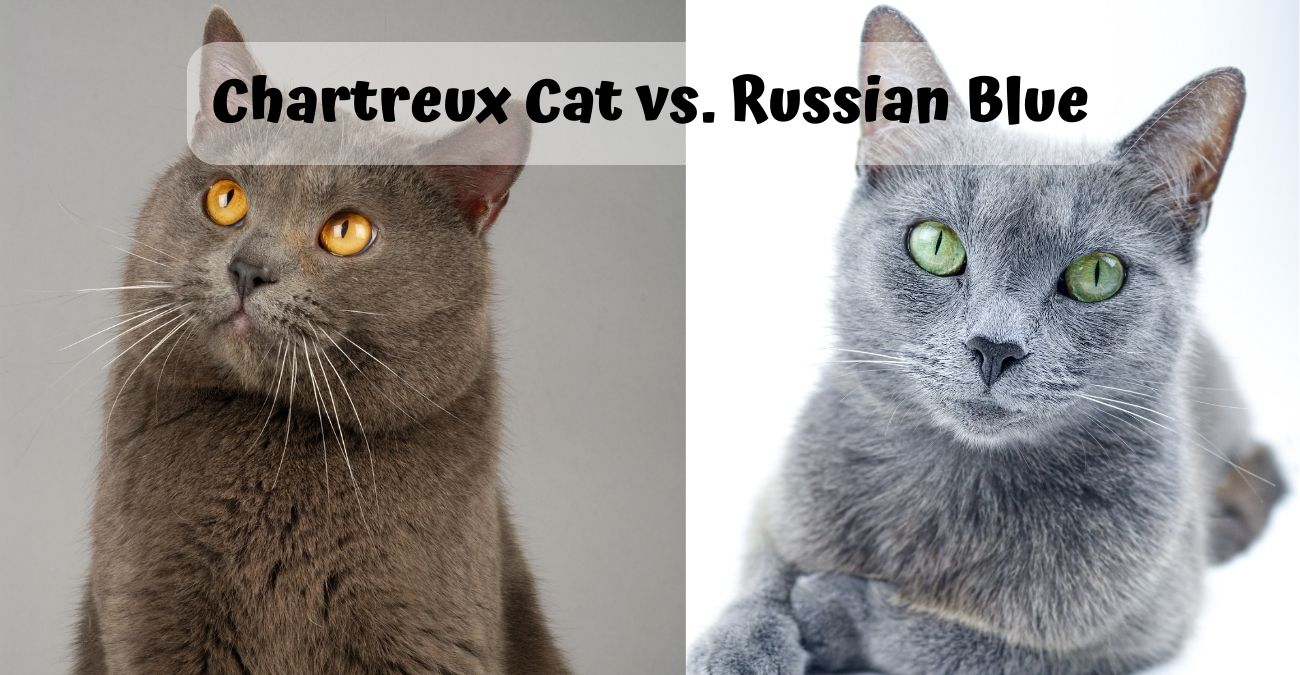The Chartreux and the Russian Blue are striking cat breeds, coveted for their distinct appearances and endearing personalities.
The Chartreux, a French breed, is recognized for its dense, woolly blue-grey coat, robust build, and quiet, sweet nature.
These cats are often described as dog-like due to their attachment to their owners and their tendency to follow them around.
Their history is steeped in mystery, but they are thought to date back to the 16th century when Carthusian monks kept them in monasteries.
Chartreux Cat vs. Russian Blue
Comparing the Chartreux and the Russian Blue is intriguing, given their subtle differences and the unique qualities each breed brings to a household.
Potential cat owners often weigh these differences when choosing a breed that fits their lifestyle and expectations for companionship.
Both breeds share a quietness and a penchant for forming strong bonds with their owners, making them excellent companions.
However, their distinctive lineages, temperament, and physical characteristics provide a wealth of considerations for anyone interested in adopting one of these blue-coated beauties.
Historical Origins and Breed Development
The Chartreux and Russian Blue cats are old breeds with rich histories stemming from France and Northern Russia, respectively.
Their development as breeds is marked by unique historical influences and distinct paths to recognition.
Chartreux History
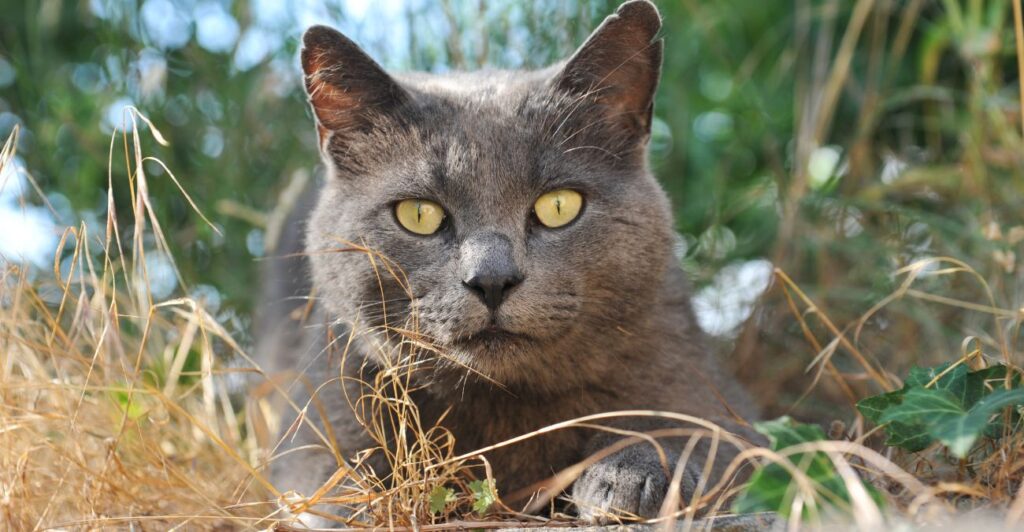
The Chartreux is an ancient French breed believed to have been named after the Carthusian monks who, according to legend, might have bred them.
Historical accounts suggest these cats were present in France since the 16th century, with archival documents mentioning blue cats at the Grand Chartreuse monastery.
Their robust build resembles a British Shorthair’s, suggesting a possibility of shared ancestry.
The breed faced near-extinction during World War II but was revitalized by careful breeding programs post-war.
- Key Entities:
- Old cat breeds: The Chartreux is among the oldest.
- French breed: Originating in France.
- Carthusian monks: Allegedly contributed to the breed’s development.
- World War II: A period during which the breed’s survival was threatened.
Russian Blue History
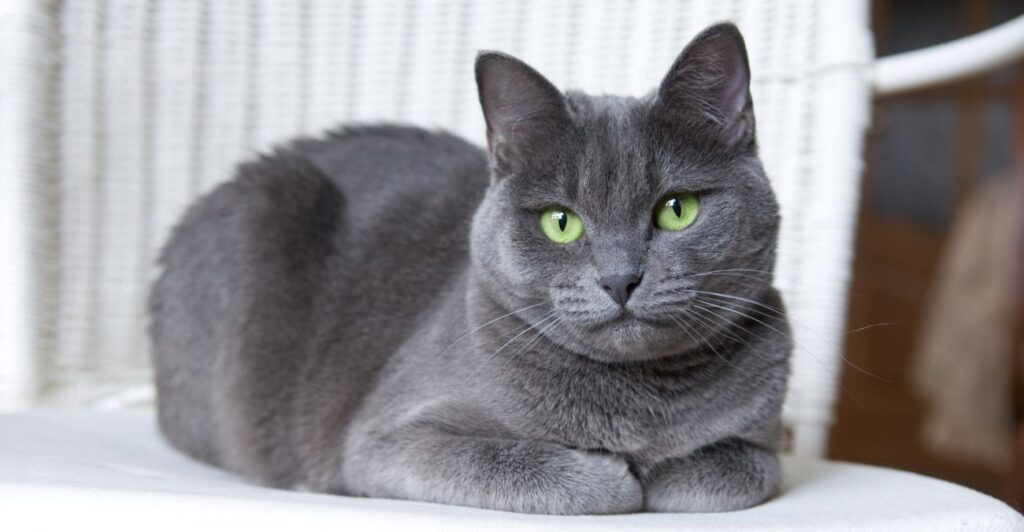
The Russian Blue Cat, known initially as the Archangel Cat, hails from the port city of Arkhangelsk in Northern Russia.
It is said that Russian czars favored these striking cats for their plush double coats and vivid green eyes.
They first appeared in England in 1875 and are believed to be related to the domestic shorthairs of the region.
It wasn’t until after World War II that breeding efforts intensified, helping standardize the breed’s characteristics.
- Key Entities:
- Northern Russia: The geographical origin of the Russian Blue.
- Archangel Cat: The Russian Blue’s former name.
- Russian czars: Historical admirers of the breed.
- World War II: An era that prompted focused breeding efforts.
Physical Characteristics and Personality Traits
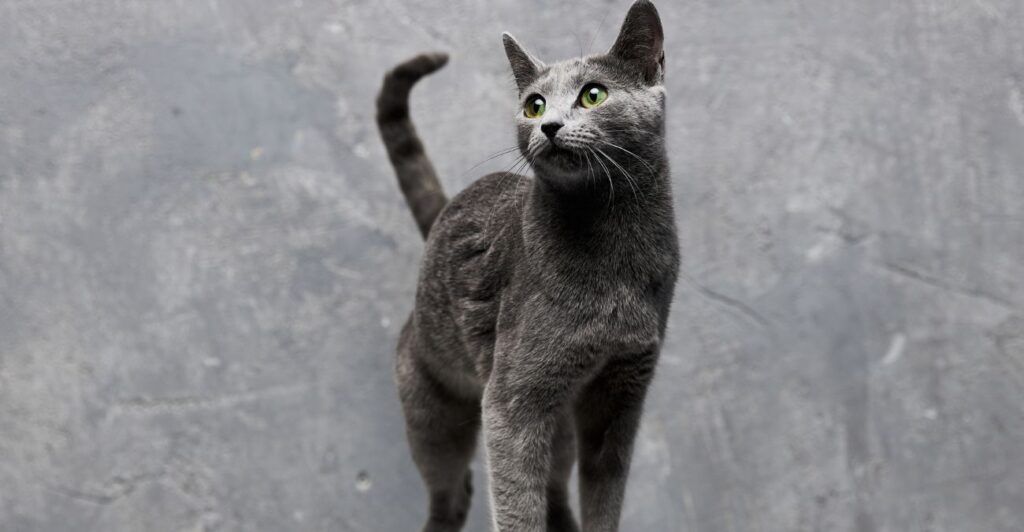
The Chartreux and the Russian Blue are medium-sized cats known for their distinctive blue-gray coats, muscular bodies, and amiable dispositions.
Appearance
Chartreux cats are recognized by their robust, muscular body, dense coat, and plush, blue-gray fur. Their heads are broad and wedge-shaped, featuring full cheeks and a powerful jaw.
The breed’s eyes are one of its most captivating features, typically being gold to copper in color.
Their short legs support a muscular physique, and their thick coat is designed to withstand harsh climates.
In contrast, Russian Blue cats boast a similarly lush, dense, and thick coat but are often more slender than their Chartreux counterparts.
These cats are cherished for their bright green eyes and signature blue-gray coat with a unique silvery sheen.
Large ears and a more angular wedge-shaped head characterize the breed. Russian Blues are known for their elegantly long legs, which contribute to their graceful movement.
| Characteristic | Chartreux | Russian Blue |
|---|---|---|
| Coat Color | Blue-gray | Blue-gray with silvery sheen |
| Eye Color | Gold to copper | Green |
| Body Type | Muscular with short legs | Slender with long legs |
| Coat Type | Dense, plush | Dense, thick, fine |
| Ears | Medium-sized | Large |
Temperament
Chartreux are often described as friendly cats, they are quiet, gentle, and enjoy forming strong bonds with their families.
Their demeanor is serenity, and they are known for their dog-like behavior, such as following their owners and responding to names. As hunters, they exhibit agility despite their muscular build.
Russian Blues are known for their reserved nature and loyalty. They may be shy with strangers but are affectionate and gentle with their trusted humans.
These cats are also playful and intelligent, enjoying interactive toys and games stimulating them mentally.
Chartreux and Russian Blue cats are considered friendly, with the Chartreux being more outgoing and the Russian Blue being more gentle and reserved.
Related: Calico vs. Tortie Cat
Health and Care
The Chartreux and Russian Blue are generally healthy breeds, but they have some specific health concerns to be mindful of. Regular grooming and proper care are essential for their well-being.
Common Health Concerns
Chartreux and Russian Blue cats are predisposed to specific genetic health issues. For Chartreux, a notable concern is patellar luxation, where the kneecap dislocates, which can cause discomfort or lameness.
They may also be prone to polycystic kidney disease (PKD), an inherited disorder that can lead to kidney failure.
Russian Blue cats may experience similar issues, with PKD being less common in this breed. However, they both can have issues related to the urinary tract: ensuring enough water is critical to their health.
- Chartreux:
- Patellar Luxation
- Polycystic Kidney Disease
- Russian Blue:
- Urinary Tract Issues
Proper veterinary care can help detect these concerns early on, allowing these domestic cats a happy life.
Grooming and Maintenance
Both breeds require regular grooming to maintain their coat and overall health. A weekly brushing is usually sufficient to keep their fur in good condition and to reduce hairballs.
This routine can be particularly beneficial for allergy sufferers, as regular grooming minimizes dander and loose hair.
- Weekly Brushing: Helps prevent matting and controls shedding.
Chartreux cats have a dense, woolly coat that benefits from the occasional brush, while the Russian Blue’s short, dense, and plush coat is noted explicitly for needing less grooming.
However, they need love and a stable care routine to thrive.
Related: Black Burmese Cat vs. Bombay
Cat Breeding and Shows
The practices of breeding and showcasing cats, particularly blue breeds like Chartreux and Russian Blue, have distinct traditions and standards in the United States.
This section outlines how these beloved breeds participate in cat shows and adhere to breed-specific standards.
Cat Show Participation
Chartreux and Russian Blue cats are frequently featured in cat shows across the United States, where cat lovers admire them for their unique characteristics.
Demonstrating the best way to present the cats, breeders, and owners prepare them meticulously for competitions. Participation in these shows involves:
- Preparation: Ensuring the cat’s coat, health, and demeanor are in top condition.
- Documentation: Having all necessary registration and pedigree papers ready, these cats often have a proud lineage to showcase.
In particular, modern Chartreux cats, known for their robust physique and rare status, can often be seen vying for titles.
Similarly, with its fine double coat and striking appearance, the Russian Blue cat breed is also a popular contender in these events.
Breed Standards
Each breed, including the Chartreux cat breed and the Russian Blue cat breed, has a set of standards that they are judged against during cat shows.
These standards emphasize the distinct differences between them:
Chartreux Cat Breed
- Body: Robust and muscular with broad shoulders.
- Coat: Dense, woolly-textured blue-gray coat.
- Eyes: Rounded, gold to copper in color.
Russian Blue Cat Breed
- Body: Slender, fine-boned, and elegant.
- Coat: Short, dense, and fine with a distinctive silvery sheen.
- Eyes: Vivid green, wide-set, and almond-shaped.
Suzanne Leger, one of the early proponents of the Chartreux breed standard, helped solidify its presence in the show circuit.
Chartreux and Russian Blues have unique appeals and challenges in meeting these breed standards.
These breeds are extraordinary pets and exemplify the pinnacle of their respective standards in a competitive show environment.
Related: 25 Signs Your Cat Loves You
Choosing the Right Cat for You
When selecting between Chartreux or Russian Blue, known for their elegant blue coats and striking eye color, it is essential to consider their characteristics and how they align with your lifestyle.
Chartreux: This breed boasts a sturdy, medium-length coat known for its robust good shape. They tend to be quiet and enjoy the indoors, making them suitable for apartment living.
Chartreux cats may be shy around new people, but they are affectionate once they warm up, which gives them the best chance of forming a strong bond with their owners.
- Traits: Quiet, patient, adaptable
- Indoor: Well-suited for apartments
- New People: Shy at first, then affectionate
Russian Blue: Renowned for their luxurious, dense blue coat and vivid green eyes, Russian Blues are an affectionate breed that cherishes a consistent routine.
They are often described as reserved but are known to be very loyal and loving towards their family. Indoor cats thrive in a calm environment and maintain good shape with their lean physique.
- Traits: Loyal, gentle, intelligent
- Indoor: Prefers stable, tranquil settings
- New People: Cautious but friendly
It is not an exaggeration to say that both breeds can be described as beautiful cats with unique blue coats, but choosing the right one depends on personal preferences and living conditions.
Consider how much time you have to invest in forming a bond and whether you’re looking for a cat with a cool cat demeanor or an average cat’s energy level.
When matching these breeds to potential owners, it’s about evaluating how your daily life aligns with the Chartreux or Russian Blue traits, ensuring a harmonious relationship between the cat and the family.
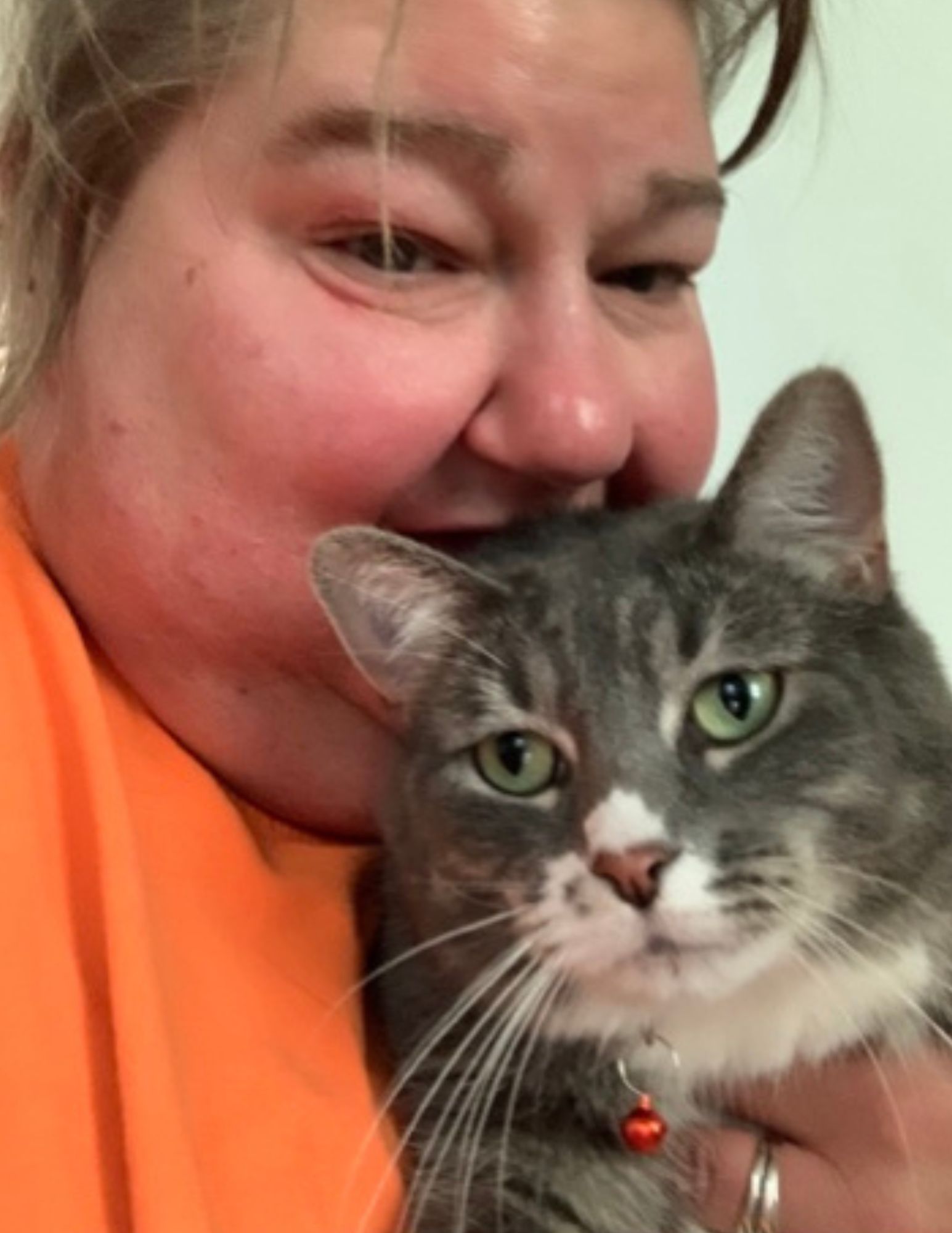
Meet Ann Haasnoot, the passionate founder of CatFurLife.com. A lifelong cat lover from Wisconsin, Ann combines her extensive feline behavior and care knowledge with her love for writing. On her website, she shares invaluable insights about cat breeds, care tips, and her experiences with her beloved furbaby, aiming to deepen the bond between cats and their human companions.

